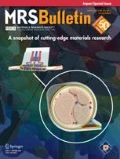Epithelial cell sheets are fascinating, dynamic, and medically important biological materials that enable the proper functioning of key tissues such as those found in hearts, lungs, and blood vessels. The composite architecture of these two-dimensional (2D) living materials includes not only cell–cell adhesions, but also intricate interactions between cellular sheets and gel-like environments, such as the extracellular matrix. A better understanding of the physical principles that guide these interactions could provide instructive insights to help better treat disease states, and could also yield useful design rules for creating biomimetic responsive materials. In the March issue of Nature Materials (DOI: 10.1038/nmat4206; p. 343), Laura Casares of the Institute for Bioengineering of Catalonia, Spain, and her colleagues report an important mechanism of mechanical failure in epithelial cell sheets placed under tension. In some scenarios cell–cell junctions, surprisingly, do not fracture during applied tension. Rather, fracture occurs after stretching is relaxed, as a result of water pressure that builds up beneath the epithelial sheets in the hydrogel substrate to which the epithelial sheets are attached.
The researchers found this unique mode of hydraulic tissue fracture by studying small islands of cell sheets (comprised of 15–20 epithelial cells each) that were micropatterned onto the surface of a polyacrylamide gel. This system was placed under controllable states of stretch during which the cells could be monitored by optical microscopy (see Figure). After uncovering the curious result of post-strain fracture (see Figure), the researchers conducted traction force microscopy, which is an optical technique that permits quantification of stress levels in the cell monolayer (a technique previously developed by corresponding author Xavier Trepat). The results were surprising. “One of the most striking things about these experiments,” said corresponding author Marino Arroyo, “is that fracture occurs when tension is lowest. You’re used to seeing cracks when you pull, but not when you compress, so this was very unexpected.” To explain the unique fracturing phenomena, the researchers then considered the role of the polyacrylamide substrate, turning to the poroelastic theory of hydrogel mechanics. This theory posits that hydrogels should experience time-dependent swelling when relaxed from a state of tension.
To support the utility of poroelastic theory for explaining their experimental system, including the initial observation of post-strain fracture, the researchers successfully tested several hypotheses derived from the theory. For example, as predicted, cell sheet cracking did not occur when using a silicone gel substrate—in contrast to polyacrylamide, silicone contains no solvent that could increase hydraulic pressure through swelling. Other predictions supported by experiment related to the effect of gel thickness on biological recovery (thicker gels take longer to release pressure, and leading to slower cell–cell crack healing on thicker gels), the effect of gel stiffness on cracking (stiffer gels build up more pressure and thus yield more cracks), and pressure distribution within the gel (the distribution is nearly constant, and accordingly cracking is uniformly distributed).
The ability of the cell sheets to gradually heal after hydraulic fracturing proved a useful experimental feature, as this enabled repetitive testing of the cell sheets. Exploration of the crack healing mechanism revealed evidence for an actomyosin-driven process: treating cells with a myosin inhibitor led to slower crack healing dynamics. The demonstrated ability to correlate molecular-level mechanisms with tissue-level healing phenotype suggests great utility for the overall testing approach. By integrating 2D cell micropatterning techniques, controlled biomechanical testing, and innovative optical microscopy, the research team has already revealed a previously unrecognized mechanism that might widely characterize cell-matrix interactions across biology and biological evolution. Such a systematic approach will be key to revealing further insights into biology’s mechanical behaviors across its many hierarchies of structure and function.

(a) Schematic overview of the testing system developed for key investigating of the response of epithelial cell sheets to mechanical stretch; PDMS is poly(dimethylsiloxane). (b) Cell sheets fracture not during stretch but after stretch cessation; arrows point to the cracks. This was found to be due to hydraulic pressure buildup in the gel substrate to which the cells are adhered. Reprinted with permission from Nature Publishing Group. © 2015.
Rights and permissions
About this article
Cite this article
Bawazer, L. Bio Focus: Swelled gels crack cells. MRS Bulletin 40, 383 (2015). https://doi.org/10.1557/mrs.2015.103
Published:
Issue Date:
DOI: https://doi.org/10.1557/mrs.2015.103

